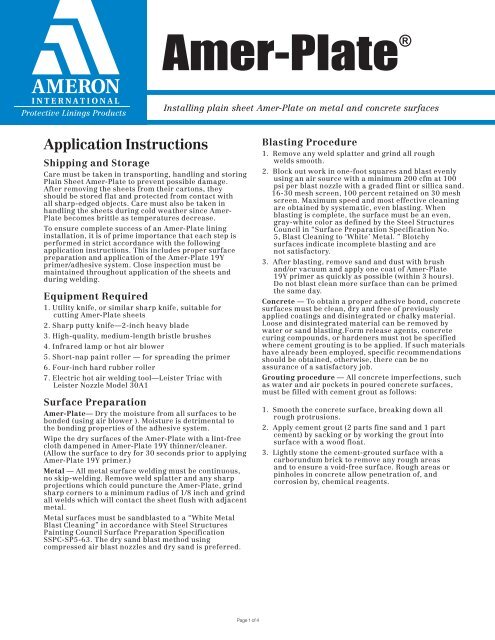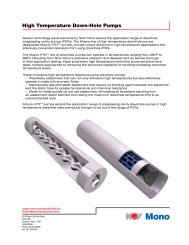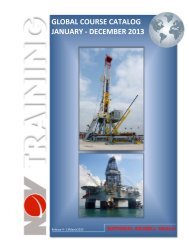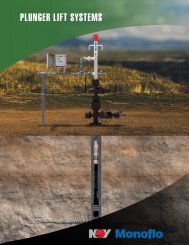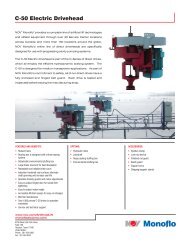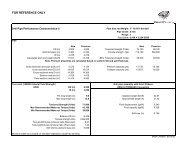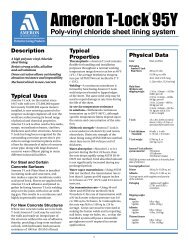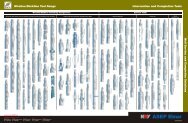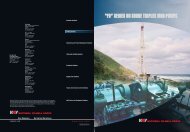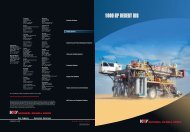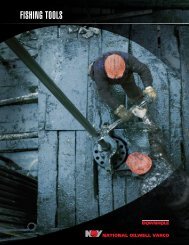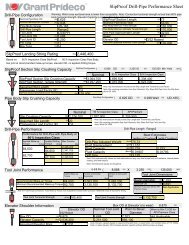Create successful ePaper yourself
Turn your PDF publications into a flip-book with our unique Google optimized e-Paper software.
Protective Linings Products<br />
Application Instructions<br />
Shipping and Storage<br />
Care must be taken in transporting, handling and storing<br />
Plain Sheet <strong>Amer</strong>-Plate to prevent possible damage.<br />
After removing the sheets from their cartons, they<br />
should be stored flat and protected from contact with<br />
all sharp-edged objects. Care must also be taken in<br />
handling the sheets during cold weather since <strong>Amer</strong>-<br />
Plate becomes brittle as temperatures decrease.<br />
To ensure complete success of an <strong>Amer</strong>-Plate lining<br />
installation, it is of prime importance that each step is<br />
performed in strict accordance with the following<br />
application instructions. This includes proper surface<br />
preparation and application of the <strong>Amer</strong>-Plate 19Y<br />
primer/adhesive system. Close inspection must be<br />
maintained throughout application of the sheets and<br />
during welding.<br />
Equipment Required<br />
1. Utility knife, or similar sharp knife, suitable for<br />
cutting <strong>Amer</strong>-Plate sheets<br />
2. Sharp putty knife—2-inch heavy blade<br />
3. High-quality, medium-length bristle brushes<br />
4. Infrared lamp or hot air blower<br />
5. Short-nap paint roller — for spreading the primer<br />
6. Four-inch hard rubber roller<br />
7. Electric hot air welding tool—Leister Triac with<br />
Leister Nozzle Model 30A1<br />
Surface Preparation<br />
<strong>Amer</strong>-Plate— Dry the moisture from all surfaces to be<br />
bonded (using air blower ). Moisture is detrimental to<br />
the bonding properties of the adhesive system.<br />
Wipe the dry surfaces of the <strong>Amer</strong>-Plate with a lint-free<br />
cloth dampened in <strong>Amer</strong>-Plate 19Y thinner/cleaner.<br />
(Allow the surface to dry for 30 seconds prior to applying<br />
<strong>Amer</strong>-Plate 19Y primer.)<br />
Metal — All metal surface welding must be continuous,<br />
no skip-welding. Remove weld splatter and any sharp<br />
projections which could puncture the <strong>Amer</strong>-Plate, grind<br />
sharp corners to a minimum radius of 1/8 inch and grind<br />
all welds which will contact the sheet flush with adjacent<br />
metal.<br />
Metal surfaces must be sandblasted to a “White Metal<br />
Blast Cleaning” in accordance with Steel Structures<br />
Painting Council Surface Preparation Specification<br />
SSPC-SP5-63. The dry sand blast method using<br />
compressed air blast nozzles and dry sand is preferred.<br />
<strong>Amer</strong>-Plate ®<br />
Installing plain sheet <strong>Amer</strong>-Plate on metal and concrete surfaces<br />
Page 1 of 4<br />
Blasting Procedure<br />
1. Remove any weld splatter and grind all rough<br />
welds smooth.<br />
2. Block out work in one-foot squares and blast evenly<br />
using an air source with a minimum 200 cfm at 100<br />
psi per blast nozzle with a graded flint or sillica sand.<br />
16-30 mesh screen, 100 percent retained on 30 mesh<br />
screen. Maximum speed and most effective cleaning<br />
are obtained by systematic, even blasting. When<br />
blasting is complete, the surface must be an even,<br />
gray-white color as defined by the Steel Structures<br />
Council in “Surface Preparation Specification No.<br />
5, Blast Cleaning to ‘White’ Metal. ” Blotchy<br />
surfaces indicate incomplete blasting and are<br />
not satisfactory.<br />
3. After blasting, remove sand and dust with brush<br />
and/or vacuum and apply one coat of <strong>Amer</strong>-Plate<br />
19Y primer as quickly as possible (within 3 hours).<br />
Do not blast clean more surface than can be primed<br />
the same day.<br />
Concrete — To obtain a proper adhesive bond, concrete<br />
surfaces must be clean, dry and free of previously<br />
applied coatings and disintegrated or chalky material.<br />
Loose and disintegrated material can be removed by<br />
water or sand blasting.Form release agents, concrete<br />
curing compounds, or hardeners must not be specified<br />
where cement grouting is to be applied. If such materials<br />
have already been employed, specific recommendations<br />
should be obtained, otherwise, there can be no<br />
assurance of a satisfactory job.<br />
Grouting procedure — All concrete imperfections, such<br />
as water and air pockets in poured concrete surfaces,<br />
must be filled with cement grout as follows:<br />
1. Smooth the concrete surface, breaking down all<br />
rough protrusions.<br />
2. Apply cement grout (2 parts fine sand and 1 part<br />
cement) by sacking or by working the grout into<br />
surface with a wood float.<br />
3. Lightly stone the cement-grouted surface with a<br />
carborundum brick to remove any rough areas<br />
and to ensure a void-free surface. Rough areas or<br />
pinholes in concrete allow penetration of, and<br />
corrosion by, chemical reagents.
Etching — All concrete surfaces, original or cement<br />
grouted, should be acid-etched to remove glaze and<br />
concrete laitance. The final surface is to be slightly<br />
granular for the adhesive to obtain a good bond.<br />
1. Etch with a solution of 1 part hydrochloric (muriatic)<br />
acid and 2 parts clean water. Apply the acid solution<br />
to the concrete by brush or garden spray until the<br />
solution runs.<br />
2. Concrete should be wet well with acid. It will bubble<br />
for 20-30 seconds and stop, at which point the acid is<br />
neutralized.<br />
3. When etching is complete, wash the surface with<br />
clean water using a garden hose. Brush during<br />
washing with a stiff brush to remove concrete<br />
salts.<br />
4. A properly etched surface should be slightly granular<br />
and free of glaze.<br />
5. On very dense, machine-troweled surfaces, several<br />
applications of acid may be required to obtain proper<br />
“tooth,” or a slightly granular surface.<br />
6. Dry surface thoroughly for at least 48 hours prior to<br />
application of adhesive products. A moist surface will<br />
not allow proper adhesion of a primer.<br />
7. After the concrete surface has been properly dried, it<br />
should be cleaned by dusting with a brush or clean<br />
cloth or by vacuuming.<br />
II. Application of <strong>Amer</strong>-Plate 19Y Primer<br />
The temperature of the surface should be in the 60-90ºF<br />
range. The following procedure should be followed for<br />
best results:<br />
1. After the metal or concrete surface has been<br />
properly prepared, it should be cleaned by dusting<br />
with a brush or clean cloth or by vacuuming.<br />
2. Stir primer thoroughly for two minutes prior to use;<br />
then stir throughout application. During mixing,<br />
loosen solids which may have settled on the bottom of<br />
the container during storage.<br />
3. Brush or roll apply one coat of <strong>Amer</strong>-Plate 19Y primer<br />
(at approximately 200 square feet/gallon) to both the<br />
metal or concrete and the <strong>Amer</strong>-Plate.<br />
4. Allow to dry one hour minimum, seven days maximum<br />
(if protected from contamination) before applying the<br />
adhesive.<br />
III. Application of <strong>Amer</strong>-Plate 19Y Adhesive<br />
1. Brush apply one coat of <strong>Amer</strong>-Plate 19Y adhesive<br />
to both the primed metal or concrete and the<br />
<strong>Amer</strong>-Plate sheet.<br />
2. Coverage should be at approximately 150 square<br />
feet/gallon. Avoid local heavy spots, sags, runs,<br />
or thin spots. One coat is generally sufficient.<br />
3. Allow adhesive to dry for 30 minutes, then apply<br />
the <strong>Amer</strong>-Plate to the adhesive-coated surface.<br />
4. Press the adhesive-coated surfaces firmly<br />
together. Pressure necessary to obtain complete<br />
bonding should be applied using a hard rubber<br />
roller or the hand.<br />
5. Mating surfaces should be assembled in not less than<br />
30 minutes and not more than one hour after application<br />
of the adhesive. Adhesive-coated <strong>Amer</strong>-Plate<br />
may be applied to the adhesive-coated surface while<br />
the adhesive is tacky (sticky) to the touch. This time<br />
period after application of adhesive is one hour<br />
maximum at 70-80ºF.<br />
AA-1/AI Page 2 of 4<br />
6. Should the prepared bonding surfaces dry to the point<br />
where they have insufficient bonding tack, apply a<br />
second coat of <strong>Amer</strong>-Plate 19Y adhesive to each<br />
bonding surface to be joined starting again at Step 1.<br />
7. If tack must be restored after a second coat of<br />
adhesive, the bonding surfaces may be reactivated by<br />
brushing with <strong>Amer</strong>-Plate 19Y thinner/cleaner.<br />
IV. Application of <strong>Amer</strong>-Plate Sheets<br />
Application will be facilitated by heating the sheets to<br />
approximately 110-120ºF (using an infrared lamp table)<br />
immediately before placing them in position. Care should<br />
be taken to avoid overexposure of the sheet to this<br />
temperature or poor bonding may result.<br />
1. Place one edge of the <strong>Amer</strong>-Plate sheet in position<br />
along the edge of the metal or concrete surface. Press<br />
down firmly, holding the remainder of the sheet up<br />
and away from the surface.<br />
2. When the edge has been affixed, roll the remainder<br />
of the sheet into position (using a 4-inch hard rubber<br />
roller), taking care to avoid inclusion of air pockets.<br />
3. After the sheet has been rolled into position, rub the<br />
surface vigorously with a soft cloth to press it firmly<br />
in place.<br />
On vertical surfaces — On vertical surfaces, application<br />
should be made from bottom to top, proceeding<br />
according to the above instructions for horizontal<br />
surfaces.<br />
Over sharp angles and bends — Due to <strong>Amer</strong>-Plates<br />
“plastic memory” (or tendency to revert to its original<br />
state), heat must be used to make the sheet conform to<br />
sharp angles or bends, such as lips of tanks or flange<br />
returns.<br />
This is accomplished as follows:<br />
1. Apply <strong>Amer</strong>-Plate 19Y primer and adhesive to both<br />
mating surfaces as for normal application. Allow to<br />
dry 30-45 minutes.<br />
2. Then, using a hot-air blower applied to the <strong>Amer</strong>-<br />
Plate heat a 2-inch wide area, 1 inch along each side<br />
of the bend or angle. (see Figure 1.) Hot-air blower<br />
temperature should be approximately 350-400ºF, or<br />
hot enough to make the heated area take on a high<br />
gloss and a soft, “chewing gum” consistency.<br />
3. Immediately — while the heated area is still in a soft<br />
state— bend the <strong>Amer</strong>-Plate sheet firmly around the<br />
angled surface, stretching (approximately 1/8 inch<br />
per 2 inches) to destroy any “plastic memory.” Do not<br />
attempt to reform more than 4-8 inches at a time.
4. Press the sheet into position by hand with a glove<br />
or cloth, taking care to avoid inclusion of air pockets.<br />
(See Figure 2.)<br />
5. Hold the sheet taut until cool to the touch. The <strong>Amer</strong>-<br />
Plate sheet will then be reformed to conform permanently<br />
to the surface of the angle being covered.<br />
6. Proceed to the next 4- to 8-inch section.<br />
7. Mechanical anchors—After the <strong>Amer</strong>-Plate Plain<br />
Sheets have adhered to the concrete vertical and<br />
overhead surfaces, mechanical anchors shall be<br />
placed on 12-inch centers each way. Anchors are to<br />
be installed after the <strong>Amer</strong>-Plate 19Y Adhesive<br />
system has adequately cured (approximately 24<br />
hours).<br />
V. Welding Joints Between <strong>Amer</strong>-Plate Sheets<br />
After installation, individual <strong>Amer</strong>-Plate sheets are<br />
joined by fusing weld strip over the butt joints.<br />
Individual <strong>Amer</strong>-Plate sheets are welded together at<br />
joints using heat and pressure to obtain a continuous<br />
plastic liner. On flat surfaces, use <strong>Amer</strong>-Plate flat weld<br />
strip. For steel tanks where sheets join at corners, use<br />
<strong>Amer</strong>-Plate corner weld strip. For concrete tanks and<br />
structures, consult liner manufacturer for corner weld<br />
recommendation. A hand-held, hot-air welding tool is<br />
used to fuse a weld strip over the joints of the sheet. The<br />
procedure for fusing weld strip is as follows:<br />
1. Clean the areas of the <strong>Amer</strong>-Plate sheets and weld<br />
strip to be welded prior to welding. Use a nonflammable,<br />
water-soluble or dispersible cleaner,<br />
such as Oakite Liqui-Det, Formula 409 or equal.<br />
2. Adjust the hot-air welding tool to provide air from<br />
approximately 500-600ºF so that the effluent air will<br />
fuse the sheet and weld strip without charring. (Use a<br />
wide slot nozzle, model 30A1). If a tool with an<br />
external air source is used, regulate air pressure to<br />
2-6 psi.<br />
3. Hold the welding tool in one hand so the tip of nozzle<br />
is 1/4 to 1/2 inch from the surface to be welded at a<br />
45 degree angle. In the other hand hold the weld<br />
strip at approximately 45 degrees to the sheet.<br />
4. Move the welding tool back and forth across the<br />
intersection between the weld strip and the sheet,<br />
moving slowly enough to cause the sheet to soften<br />
and become “tacky” and a small bead of molten<br />
material to form in front of the weld strip, and on<br />
both sides.<br />
5. As the heat from the welding tool softens the sheet<br />
and the bead of molten material forms in front of the<br />
weld strip, press the weld strip firmly downward<br />
toward the sheet.<br />
6. As it progresses, center the weld strip over the joint<br />
as closely as practical.<br />
7. When properly welded, a small bead of molten<br />
material will be visible along each edge of the weld<br />
strip.<br />
Note: <strong>Amer</strong>-Plate is permanently thermoplastic and may<br />
be rewelded at any time during its service life following<br />
the above procedure.<br />
VI. Special Provisions<br />
1. If required for workability, <strong>Amer</strong>-Plate 19Y adhesive<br />
may be thinned up to 10 percent by volume with<br />
<strong>Amer</strong>-Plate 19Y thinner/cleaner. (No more than one<br />
pint of <strong>Amer</strong>-Plate 19Y thinner/cleaner should be<br />
added per gallon of adhesive.)<br />
2. Do not apply adhesive or primer to areas of <strong>Amer</strong>-<br />
Plate which will be joined by heat welding, as these<br />
materials will prevent proper fusion during welding.<br />
Inspect seam areas prior to welding. In confined<br />
areas, remove any adhesive or primer using a Model<br />
No. 3040 Red Devil® Scraper (or equal). In wellventilated<br />
areas, <strong>Amer</strong>-Plate 19Y thinner/cleaner<br />
can be used for removal.<br />
3. <strong>Amer</strong>-Plate 19Y adhesive is characterized by a high<br />
initial or “green” strength; however, one week is<br />
required to develop maximum bond. The required<br />
bond can be obtained with one coat of adhesive<br />
applied over the primer; however, bond strength can<br />
be increased by applying two coats of adhesive over<br />
the dry primer. Allow30 minutes drying time<br />
between adhesive coats.<br />
4. Warming adhesive-coated sheets up to 120ºF for a<br />
short time (not more than 10 minutes) to improve the<br />
flexibility prior to placement will not adversely affect<br />
the adhesive bond. Warming the sheet normally<br />
improves the overall bond by facilitating uniform<br />
contact with the underlying surface.<br />
Caution! Use hot-air blower for warming and welding.<br />
Do not use open flames.<br />
Safety precautions required (in tanks or confined<br />
areas).<br />
Whenever materials containing volatile solvents or toxic<br />
substances are used, proper ventilation and protective<br />
measures must be provided during application and<br />
drying to keep solvent vapor concentrations within safe<br />
limits, and to protect personnel against toxic hazards.<br />
This is especially true in confined spaces, such as tank<br />
interiors, pipelines, and tunnels. Consult Code of Federal<br />
Regulations Title 29-Labor and applicable state and local<br />
regulations on safe practices in coating operations.<br />
Keep solvent-containing materials away from heat,<br />
sparks, and open flame. Avoid inhalation of vapors or<br />
spray mist. Avoid contact with eyes or skin. Keep<br />
containers tightly closed and upright to prevent leakage<br />
when not in use.<br />
Department of Labor Material Safety Data Sheets are<br />
available on request.<br />
VII. Testing<br />
When installation and welding is complete, the entire<br />
lining and weld areas should be tested with an approved<br />
electrical hole detector (Tinker and Rasor Model AP-W<br />
or equal) with the instrument set at 20,000 volts. Any<br />
imperfections must be repaired before placing the lining<br />
in service.<br />
Page 3 of 4 AA-1/AI
Warning: <strong>Amer</strong>-Plate19Y primer, adhesive and thinner/<br />
cleaner are flammable. Keep away from heat and flame.<br />
Keep containers closed. Use with adequate ventilation.<br />
Avoid prolonged breathing of vapor. Avoid prolonged or<br />
repeated contact with skin. If used in confined areas,<br />
observe the following precautions to prevent hazards of<br />
fire or explosion or damage to the health:<br />
1. Continuously circulate adequate fresh air during<br />
application and drying to keep solvent fumes below<br />
20 percent of the explosive limit of 1/4 percent by<br />
volume of solvent in the air.<br />
2. Use fresh air masks and explosion-proof equipment.<br />
3. Prohibit all flames, sparks, welding, and smoking.<br />
Also refer to “<strong>Amer</strong>on Safety Precautions.”<br />
Safety Precautions<br />
Read material safety data sheet before use. Safety<br />
precautions must be strictly followed during storage,<br />
handling and use.<br />
CAUTION – Improper use and handling of this product<br />
can be hazardous to health.<br />
Do not use this product without first taking all<br />
appropriate safety measures to prevent property<br />
damage and injuries. These measures may include,<br />
without limitation: implementation of proper<br />
ventilation, use of proper lamps, wearing of proper<br />
protective clothing and masks, tenting and proper<br />
separation of application areas. Consult your<br />
supervisor. Proper ventilation and protective<br />
measures must be provided during application and<br />
drying to keep spray mist concentrations within safe<br />
limits and to protect against toxic hazards. Necessary<br />
safety equipment must be used and ventilation<br />
requirements carefully observed, especially in<br />
confined or enclosed spaces, such as tank interior<br />
and buildings.<br />
This product is to be used by those knowledgeable<br />
about proper application methods. <strong>Amer</strong>on makes no<br />
recommendation about the types of safety measures<br />
that may need to be adopted because these depend on<br />
application environment and space, of which <strong>Amer</strong>on<br />
is unaware and over which it has no control.<br />
If you do not fully understand these warnings and<br />
instructions or if you cannot strictly comply with them,<br />
do not use the product.<br />
Note: Consult Code of Federal Regulations Title 29,<br />
Labor, parts 1910 and 1915 concerning occupational<br />
safety and health standards and regulations, as well as<br />
any other applicable federal, state and local regulations<br />
on safe practices in coating operations.<br />
This product is for industrial use only. Not for<br />
residential use in California.<br />
Warranty<br />
<strong>Amer</strong>on warrants its products to be free from defects in<br />
material and workmanship. <strong>Amer</strong>on’s sole obligation<br />
and Buyer’s exclusive remedy in connection with the<br />
products shall be limited, at <strong>Amer</strong>on’s option, to either<br />
replacement of products not conforming to this Warranty<br />
or credit to Buyer’s account in the invoiced amount of the<br />
nonconforming products. Any claim under this Warranty<br />
must be made by Buyer to <strong>Amer</strong>on in writing within five<br />
(5) days of Buyer’s discovery of the claimed defect, but in<br />
no event later than the expiration of the applicable shelf<br />
life, or one year from the delivery date, whichever is<br />
earlier. Buyer’s failure to notify <strong>Amer</strong>on of such nonconformance<br />
as required herein shall bar Buyer from<br />
recovery under this Warranty.<br />
<strong>Amer</strong>on makes no other warranties concerning the<br />
product. No other warranties, whether expressed,<br />
implied, or statutory, such as warranties of<br />
merchantability or fitness for a particular purpose,<br />
shall apply. In no event shall <strong>Amer</strong>on be liable for<br />
consequential or incidental damages.<br />
Any recommendation or suggestion relating to the use of<br />
the products made by <strong>Amer</strong>on, whether in its technical<br />
literature, or in response to specific inquiry, or<br />
otherwise, is based on data believed to be reliable;<br />
however, the products and information are intended for<br />
use by Buyers having requisite skill and know-how in the<br />
industry, and therefore it is for Buyer to satisfy itself of<br />
the suitability of the products for its own particular use<br />
and it shall be deemed that Buyer has done so, at its sole<br />
discretion and risk. Variation in environment, changes in<br />
procedures of use, or extrapolation of data may cause<br />
unsatisfactory results.<br />
Limitation of Liability<br />
<strong>Amer</strong>on’s liability on any claim of any kind, including<br />
claims based upon <strong>Amer</strong>on’s negligence or strict liability,<br />
for any loss or damage arising out of, connected with, or<br />
resulting from the use of the products, shall in no case<br />
exceed the purchase price allocable to the products or<br />
part thereof which give rise to the claim.<br />
In no event shall <strong>Amer</strong>on be liable for consequential or<br />
incidental damages.<br />
<strong>Amer</strong>on International Corporation is a multinational<br />
manufacturer of highly-engineered products and<br />
materials for the chemical, industrial, energy, transportation<br />
and infrastructure markets. Traded on the<br />
New York Stock Exchange (AMN), <strong>Amer</strong>on is a leading<br />
producer of water transmission lines and fabricated<br />
steel products, such as wind towers; fiberglass<br />
composite pipe; for transporting oil, chemicals and<br />
corrosive fluids and specialized materials and<br />
products used in infrastructure projects. The company<br />
buinesses operate in North <strong>Amer</strong>ica, South <strong>Amer</strong>ica,<br />
Europe and Asia. It also participates in several jointventure<br />
companies in the U.S. and the Middle East.<br />
<strong>Amer</strong>on Protective Linings • 201 North Berry Street, P.O. Box 1629 Brea, CA 92821<br />
Phone: (714) 256-7755 • Fax: (714) 256-7750 Email: t-lock@ameron.com • www.amerontlock.com<br />
AA-1/AI Page 4 of 4 ©2003 <strong>Amer</strong>on International • Printed in U.S.A. • R9/09 AA-1


